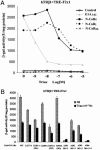E1A and a nuclear receptor corepressor splice variant (N-CoRI) are thyroid hormone receptor coactivators that bind in the corepressor mode
- PMID: 15849266
- PMCID: PMC1088377
- DOI: 10.1073/pnas.0501491102
E1A and a nuclear receptor corepressor splice variant (N-CoRI) are thyroid hormone receptor coactivators that bind in the corepressor mode
Abstract
Unliganded thyroid hormone (TH) receptors (TRs) and other nuclear receptors (NRs) repress transcription of hormone-activated genes by recruiting corepressors (CoRs), such as NR CoR (N-CoR) and SMRT. Unliganded TRs also activate transcription of TH-repressed genes. Some evidence suggests that these effects also involve TR/CoR contacts; however, the precise reasons that CoRs activate transcription in these contexts are obscure. Unraveling these mechanisms is complicated by the fact that it is difficult to decipher direct vs. indirect effects of TR-coregulator contacts in mammalian cells. In this study, we used yeast, Saccharomyces cerevisiae, which lack endogenous NRs and NR coregulators, to determine how unliganded TRs can activate transcription. We previously showed that adenovirus 5 early-region 1A coactivates unliganded TRs in yeast, and that these effects are blocked by TH. We show here that human adenovirus type 5 early region 1A (E1A) contains a short peptide (LDQLIEEVL amino acids 20-28) that resembles CoR-NR interaction motifs (CoRNR boxes), and that this motif is required for TR binding and coactivation. Although full-length N-CoR does not coactivate TR in yeast, a naturally occurring N-CoR variant (N-CoR(I)) and an artificial N-CoR truncation (N-CoR(C)) that retain CoRNR boxes but lack N-terminal repressor domains behave as potent and direct TH-repressed coactivators for unliganded TRs. We conclude that E1A and N-CoR(I) are naturally occurring TR coactivators that bind in the typical CoR mode and suggest that similar factors could mediate transcriptional activation by unliganded TRs in mammals.
Figures




References
-
- Cheng, S. Y. (2000) Rev. Endocr. Metab. Disord. 1, 9-18. - PubMed
-
- Yen, P. M. (2001) Physiol. Rev. 81, 1097-1142. - PubMed
-
- Horlein, A. J., Naar, A. M., Heinzel, T., Torchia, J., Gloss, B., Kurokawa, R., Ryan, A., Kamel, Y., Soderstrom, M., Glass, C. K., et al. (1995) Nature 377, 397-404. - PubMed
-
- Chen, J. D. & Evans, R. M. (1995) Nature 377, 454-457. - PubMed
Publication types
MeSH terms
Substances
Grants and funding
LinkOut - more resources
Full Text Sources
Molecular Biology Databases
Research Materials

